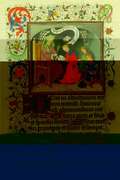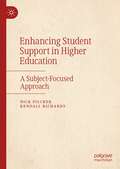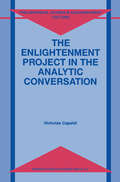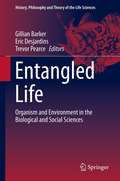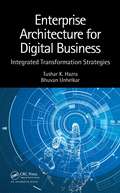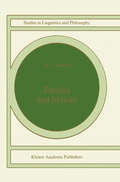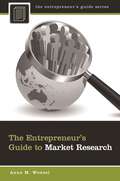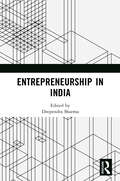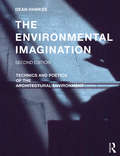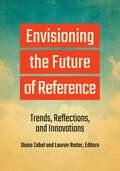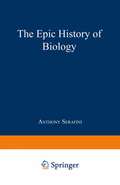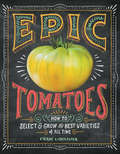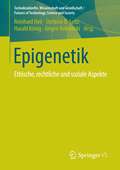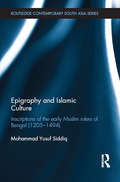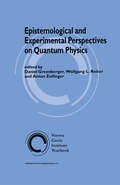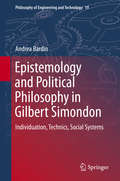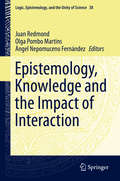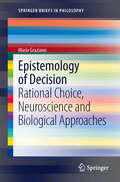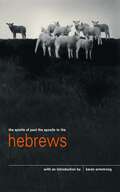- Table View
- List View
English School Exercises, 1420-1530 (Studies And Texts #181 (PDF))
by Nicholas Orme Pontifical Institute of Mediaeval Studies Staff"In his latest of many distinguished contributions to the history of medieval education, Nicholas Orme edits and translates into modern English twelve sets of the translation exercises known as 'latins.' Devised to teach Anglophone boys the basics of Latin composition, these hundreds of short texts do much more than illustrate pedagogical methods that continued in use even as medieval gave way to humanist Latin in the schools. They provide fascinating glimpses of fifteenth- and early sixteenth-century English popular culture and everyday life as viewed by adolescents aspiring to worldly success while enduring outbreaks of plague, bad meals, and especially the master's harsh discipline. In his introductions and annotations, Orme draws on his unsurpassed knowledge of English grammar schools to contextualize and enhance these vivid images. Historians of education may be the principal audience for the book, but anyone interested in medieval language, customs, and institutions will consult it with pleasure and profit." -Martin Camargo, University of Illinois at Urbana-Champaign
Enhancing Student Support in Higher Education: A Subject-Focused Approach
by Nick Pilcher Kendall RichardsThis book is about supporting students in Higher Education using language, and specifically using a combination of written text based linguistic approaches alongside and with other non-text related languages. The authors call this a beyond-text subject based approach and argue that this can more effectively help students. The book first outlines and describes a ‘paradigm of linguistics’ that sees support as being only possible through linguistics written text approaches. It then describes how the authors have found through their own research studies that such approaches do not go far enough to best support students. They offer alternatives and justify them theoretically and empirically, and also suggest ways in which others can use similar approaches to best support students in HE. This book will be of interest to practitioners, students, teachers and researchers in the fields of Applied Linguistics, TESOL, English Medium Instruction (EMI), EAP and language education policy.
The Enlightenment Project in the Analytic Conversation (Philosophical Studies in Contemporary Culture #4)
by N. CapaldiAnalytic philosophy has been a dominant intellectual movement in the 20th century and a reflection of the cultural pre-eminence of scientism. In response to analytic philosophy's peculiar reticence (and inability) to discuss itself, this book provides its first comprehensive history and critique. The central element in the analytic conversation has been the Enlightenment Project: the appeal to an autonomous human reason, freed of any higher authority and channeling itself through science as its privileged tool. This centrality is demonstrated by systematically examining its presence and development in the philosophy of science, metaphysics, epistemology, language, psychology, social science, ethics, political philosophy, and the history of philosophy. This journey highlights the internal logical disintegration of that project. Post-modern relativism is its natural offspring and not a viable alternative. The Enlightenment Project's conception of physical science is defective; this defective conception of physical science renders the analytic conception of social science, philosophical psychology, and epistemology defective; and that defective conception of the human condition leads to defective conceptions of both moral and political philosophy, specifically the idea of social engineering or social technology. Throughout the book, an alternative conception of philosophy is presented as a way out of the abyss of analysis, an alternative that reconnects philosophy with the mainstream of Western civilization and initiates the process of providing a coherent cultural narrative. This book will be of particular interest to any sophisticated reader concerned about the lack of a coherent cultural narrative.
Entangled Life: Organism and Environment in the Biological and Social Sciences (History, Philosophy and Theory of the Life Sciences #4)
by Gillian Barker Eric Desjardins Trevor PearceThis volume explores the interactions between organisms and their environments and how this “entanglement” is a fundamental aspect of all life. It brings together the work and ideas of historians, philosophers, biologists, and social scientists, uniting a range of new perspectives, methods, and frameworks for examining and understanding the ways that organisms and environments interact.The volume is organized into three main sections: historical perspectives, contested models, and emerging frameworks. The first section explores the origins of the modern idea of organism-environment interaction in the mid-nineteenth century and its development by later psychologists and anthropologists. In the second section, a variety of controversial models—from mathematical representations of evolution to model organisms in medical research—are discussed and reframed in light of recent questions about the interplay between organisms and environment. The third section investigates several new ideas that have the potential to reshape key aspects of the biological and social sciences. Populations of organisms evolve in response to changing environments; bodies and minds depend on a wide array of circumstances for their development; cultures create complex relationships with the natural world even as they alter it irrevocably. The chapters in this volume share a commitment to unraveling the mysteries of this entangled life.
Enterprise Architecture for Digital Business: Integrated Transformation Strategies
by Tushar K. Hazra Bhuvan UnhelkarEnterprise Architecture (EA) is an essential part of the fabric of a business; however, EA also transcends and transforms technology and moves it into the business space. Therefore, EA needs to be discussed in an integrated, holistic, and comprehensive manner. Only such an integrated approach to EA can provide the foundation for a transformation that readies the business for the myriad enterprise-wide challenges it will face. Highly disruptive technologies such as Big Data, Machine Learning, and Mobile and Cloud Computing require a fine balance between their business and technical aspects as an organization moves forward with its digital transformation. This book focuses on preparing all organizations – large and small – and those wishing to move into them for the impact of leveraging these emerging, disruptive, and innovative technologies within the EA framework.
Enterprise Architecture for Digital Business: Integrated Transformation Strategies
by Tushar K. Hazra Bhuvan UnhelkarEnterprise Architecture (EA) is an essential part of the fabric of a business; however, EA also transcends and transforms technology and moves it into the business space. Therefore, EA needs to be discussed in an integrated, holistic, and comprehensive manner. Only such an integrated approach to EA can provide the foundation for a transformation that readies the business for the myriad enterprise-wide challenges it will face. Highly disruptive technologies such as Big Data, Machine Learning, and Mobile and Cloud Computing require a fine balance between their business and technical aspects as an organization moves forward with its digital transformation. This book focuses on preparing all organizations – large and small – and those wishing to move into them for the impact of leveraging these emerging, disruptive, and innovative technologies within the EA framework.
Entities and Indices (Studies in Linguistics and Philosophy #41)
by M.J. CresswellIn ordinary discourse we appear to ta1k about many things that have seemed mysterious to philosophers. We say that there has been a hitch in our arrangements or that the solution to the problem required us to examine all the probable outcomes of our action. So it would seem that we speak as if in addition to eloeks, mountains, queens and grains of sand there are hitches, arrangements, solutions, probiems, and probable outcomes. It is not immediately obvious when we must take such ta1k as really assuming that there are such to develop tests for things, and one of the tasks in this book is discerning what has eome to be called ontological commitment, in naturallanguage. Among the entities that natural language appears to make reference to are those connected with temporal and modal discourse, times, possibilities, and so on. Such entities play a crueial role in the kind of semantieal theories that I and others have defended over many years. These theories are based on the idea that an essential part of the meaning of a sentence is constituted by the conditions under whieh that sentenee is true. To know what a sentence says is to know what the world would have to be !ike for that sentence to be true.
The Entrepreneur's Guide to Market Research (The Entrepreneur's Guide)
by Anne M. WenzelPlanning your new business starts here. This invaluable guide arms entrepreneurs with all they need to know to research and analyze potential markets—key steps in constructing effective marketing plans, establishing sound financial forecasts, and finding backers.The Entrepreneur's Guide to Market Research is a must-have for anyone who wants to start or expand a business. This fact-filled, actionable book offers a step-by-step guide to researching and documenting the market potential of any product or service, something that is an essential—and too-often overlooked—part of constructing a workable business plan.Author Anne M. Wenzel, herself a principal in a market research firm, takes entrepreneurs through the process of assessing such things as market size and growth, market trends and needs, emerging technologies, competition, and distribution patterns. She discusses types of market research and makes it clear what market research can and can't do to improve the chances of success. Finally, the book shows entrepreneurs how to document findings as part of a well-written business plan that will be invaluable for their own decision-making and can also be shared with potential partners, lenders, and investors.
The Entrepreneur's Guide to Market Research (The Entrepreneur's Guide)
by Anne M. WenzelPlanning your new business starts here. This invaluable guide arms entrepreneurs with all they need to know to research and analyze potential markets—key steps in constructing effective marketing plans, establishing sound financial forecasts, and finding backers.The Entrepreneur's Guide to Market Research is a must-have for anyone who wants to start or expand a business. This fact-filled, actionable book offers a step-by-step guide to researching and documenting the market potential of any product or service, something that is an essential—and too-often overlooked—part of constructing a workable business plan.Author Anne M. Wenzel, herself a principal in a market research firm, takes entrepreneurs through the process of assessing such things as market size and growth, market trends and needs, emerging technologies, competition, and distribution patterns. She discusses types of market research and makes it clear what market research can and can't do to improve the chances of success. Finally, the book shows entrepreneurs how to document findings as part of a well-written business plan that will be invaluable for their own decision-making and can also be shared with potential partners, lenders, and investors.
Entrepreneurship in India
by Deependra SharmaThis book introduces readers and students to the entrepreneurial process. It is important as evidence has suggested that the probability of entrepreneurs’ success enhances when they thoroughly appreciate the components of the entrepreneurial process as well as how to effectively use them. The fact that nearly 33 percent of new firms fail within the first two years while twenty percent fail within four to five years of their existence makes it evident that while many people are highly motivated to start new firms, motivation alone is not sufficient, rather it should be coupled with relevant information, a strong business idea, a well-crafted business plan, and sound execution to maximize chances for success. This work offers an insightful and a practical guide to the process of launching and growing an entrepreneurial organisation with success. It will therefore serve as an important resource to students of Entreprenuership and to anyone interested in the field, academically or practically.
Entrepreneurship in India
by Deependra SharmaThis book introduces readers and students to the entrepreneurial process. It is important as evidence has suggested that the probability of entrepreneurs’ success enhances when they thoroughly appreciate the components of the entrepreneurial process as well as how to effectively use them. The fact that nearly 33 percent of new firms fail within the first two years while twenty percent fail within four to five years of their existence makes it evident that while many people are highly motivated to start new firms, motivation alone is not sufficient, rather it should be coupled with relevant information, a strong business idea, a well-crafted business plan, and sound execution to maximize chances for success. This work offers an insightful and a practical guide to the process of launching and growing an entrepreneurial organisation with success. It will therefore serve as an important resource to students of Entreprenuership and to anyone interested in the field, academically or practically.
The Environmental Imagination: Technics and Poetics of the Architectural Environment
by Dean HawkesThe Environmental Imagination explores the relationship between tectonics and poetics in environmental design in architecture. Working thematically and chronologically from the eighteenth century to the present day, this book redefines the historiography of environmental design by looking beyond conventional histories to argue that the environments within buildings are a collaboration between poetic intentions and technical means. In a sequence of essays, the book traces a line through works by leading architects of the nineteenth and twentieth centuries that illustrate the impact of new technologies on the conception and realisation of environments in buildings. In this, a consideration of the qualitative dimension of environment is added to the primarily technological narratives of other accounts. In this second edition, the book has been substantially rewritten and restructured to include further research conducted in the decade since the first edition. A number of important buildings have been revisited, in order to extend the descriptions of their environments, and studies have been made of a number of newly studied, significant buildings. A completely new essay offers an environmental interpretation of Luis Barragán’s magical own house in Mexico City and the earlier studies of buildings by Peter Zumthor have been gathered into a single, extended essay that includes a body of new research. On the fiftieth anniversary of the publication of Reyner Banham’s, The Architecture of the Well-tempered Environment, the book concludes with a critical tribute to that seminal text. The Environmental Imagination will appeal to academics and practitioners with interests in the history, theory and technology of architecture.
The Environmental Imagination: Technics and Poetics of the Architectural Environment
by Dean HawkesThe Environmental Imagination explores the relationship between tectonics and poetics in environmental design in architecture. Working thematically and chronologically from the eighteenth century to the present day, this book redefines the historiography of environmental design by looking beyond conventional histories to argue that the environments within buildings are a collaboration between poetic intentions and technical means. In a sequence of essays, the book traces a line through works by leading architects of the nineteenth and twentieth centuries that illustrate the impact of new technologies on the conception and realisation of environments in buildings. In this, a consideration of the qualitative dimension of environment is added to the primarily technological narratives of other accounts. In this second edition, the book has been substantially rewritten and restructured to include further research conducted in the decade since the first edition. A number of important buildings have been revisited, in order to extend the descriptions of their environments, and studies have been made of a number of newly studied, significant buildings. A completely new essay offers an environmental interpretation of Luis Barragán’s magical own house in Mexico City and the earlier studies of buildings by Peter Zumthor have been gathered into a single, extended essay that includes a body of new research. On the fiftieth anniversary of the publication of Reyner Banham’s, The Architecture of the Well-tempered Environment, the book concludes with a critical tribute to that seminal text. The Environmental Imagination will appeal to academics and practitioners with interests in the history, theory and technology of architecture.
Envisioning the Future of Reference: Trends, Reflections, and Innovations
by Diane Zabel Lauren ReiterOffering a broad overview of consequential changes in the landscape of reference services, this guide also provides practical guidance on how to meet the new challenges they present.For the past decade, librarians have been lamenting the demise of reference services. Encouraging recent research shows that reference librarians are actually in more demand than ever; however, nearly everything about reference has changed—from technologies, tools, and techniques to models of service.What are these changes, and how can the profession respond to and prepare for shifting priorities and user needs? In this volume, business librarians Diane Zabel and Lauren Reiter bring together a host of experts to answer these timely questions. Topics range from the education and training of professionals to meeting the needs and wants of employers. Covered are trends in chat reference, research consultations, do-it-yourself reference, tracking trends with user populations, assessment, and data-driven decisions about reference services.Grounded in the principle that, regardless of the evolutions in service, the user remains at the center of reference, this guide offers readers an exciting look at the future of this important public service.
Envisioning the Future of Reference: Trends, Reflections, and Innovations
Offering a broad overview of consequential changes in the landscape of reference services, this guide also provides practical guidance on how to meet the new challenges they present.For the past decade, librarians have been lamenting the demise of reference services. Encouraging recent research shows that reference librarians are actually in more demand than ever; however, nearly everything about reference has changed—from technologies, tools, and techniques to models of service.What are these changes, and how can the profession respond to and prepare for shifting priorities and user needs? In this volume, business librarians Diane Zabel and Lauren Reiter bring together a host of experts to answer these timely questions. Topics range from the education and training of professionals to meeting the needs and wants of employers. Covered are trends in chat reference, research consultations, do-it-yourself reference, tracking trends with user populations, assessment, and data-driven decisions about reference services.Grounded in the principle that, regardless of the evolutions in service, the user remains at the center of reference, this guide offers readers an exciting look at the future of this important public service.
The Epic History of Biology
by Anthony SerafiniThe search for our elusive human origins and an understanding of the mysteries of the human body have challenged the most inquisitive and imaginative thinkers from Egyptian times through the twentieth century. In The Epic History of Biology, Anthony Serafini - a distinguished philosopher and historian of science - regales the reader with the triumphs and failures of the geniuses of the life sciences. The subtleties of the animal kingdom - anatomy, zoology, and reproduction - along with the complexities of the plant kingdom, have fascinated humanity as far back as 5000 years ago. Astounding ancient knowledge of the arcane curing powers of herbs as well as early experimentation with different chemical combinations for such purposes as mummification led to today's biological technology. Innovative pioneers such as Aristotle, Galen, Hippocrates, and Vesalius challenged the limits of knowledge and single-mindedly pursued their work, often in the face of blind superstition. In superb, lyrical prose Serafini recreates the ideas and theories of these revolutionaries from ancient times through today, against the backdrop of the dogma and prejudices of their time. He explores the inspired revelations that gave birth to such discoveries as the controversial theory of evolution, the humble origins of genetics, the fantastic predictions of quantum mechanics, and the infinite promise of computer technology. Even today the biological sciences are undergoing rapid and kaleidoscopic changes. Every new insight gives rise to a myriad of new ethical questions and responsibilities. The Epic History of Biology confronts these issues head on and predicts the wondrous new directions biology will follow.
Epic Tomatoes: How to Select and Grow the Best Varieties of All Time
by Craig LeHoullierSavor your best tomato harvest ever! Craig LeHoullier provides everything a tomato enthusiast needs to know about growing more than 200 varieties of tomatoes, from planting to cultivating and collecting seeds at the end of the season. He also offers a comprehensive guide to various pests and tomato diseases, explaining how best to avoid them. With beautiful photographs and intriguing tomato profiles throughout, Epic Tomatoes celebrates one of the most versatile and delicious crops in your garden.
Epigenetik: Ethische, rechtliche und soziale Aspekte (Technikzukünfte, Wissenschaft und Gesellschaft / Futures of Technology, Science and Society)
by Reinhard Heil Stefanie B. Seitz Harald König Jürgen RobienskiInnerhalb der letzten zehn Jahre hat sich die Epigenetik als ein Zweig der Molekulargenetik herausgebildet und erlebt einen regelrechten Hype. Die moderne Epigenetik vereint Wissenschaftlerinnen und Wissenschaftler aus den Lebenswissenschaften, der organischen Chemie, der Informatik und den Ingenieurwissenschaften bei der Beantwortung der Frage, wie Umwelteinflüsse die Genexpression langfristig und bis in die folgenden Generationen beeinflussen können. Der Band untersucht die wenig beachteten ethischen, rechtlichen und sozialen Aspekte der Epigenetik aus interdisziplinärer Perspektive.
Epigraphy and Islamic Culture: Inscriptions of the Early Muslim Rulers of Bengal (1205-1494) (Routledge Contemporary South Asia Series)
by Mohammad Yusuf SiddiqArchitectural inscriptions are a fascinating aspect of Islamic cultural heritage because of their rich and diverse historical contents and artistic merits. These inscriptions help us understand the advent of Islam and its gradual diffusion in Bengal, which eventually resulted in a Muslim majority region, making the Bengali Muslims the second largest linguistic group in the Islamic world. This book is an interpretive study of the Arabic and Persian epigraphic texts of Bengal in the wider context of a rich epigraphic tradition in the Islamic world. While focusing on previously untapped sources, it takes a fresh look into the Islamic inscriptions of Bengal and examines the inner dynamics of the social, intellectual and religious transformations of this eastern region of South Asia. It explores many new inscriptions including Persian epigraphs that appeared immediately after the Muslim conquest of Bengal indicating an early introduction of Persian language in the region through a cultural interaction with Khurasan and Central Asia. In addition to deciphering and editing the epigraphic texts, the information derived from them has been analyzed to construct the political, administrative, social, religious and cultural scenario of the period. The first survey of the Muslim inscriptions in India ever to be attempted on this scale, the book reveals the significance of epigraphy as a source for Islamic history and culture. As such, it will be of interest to students and scholars of Asian Studies, Asian History and Islamic Studies.
Epigraphy and Islamic Culture: Inscriptions of the Early Muslim Rulers of Bengal (1205-1494) (Routledge Contemporary South Asia Series)
by Mohammad Yusuf SiddiqArchitectural inscriptions are a fascinating aspect of Islamic cultural heritage because of their rich and diverse historical contents and artistic merits. These inscriptions help us understand the advent of Islam and its gradual diffusion in Bengal, which eventually resulted in a Muslim majority region, making the Bengali Muslims the second largest linguistic group in the Islamic world. This book is an interpretive study of the Arabic and Persian epigraphic texts of Bengal in the wider context of a rich epigraphic tradition in the Islamic world. While focusing on previously untapped sources, it takes a fresh look into the Islamic inscriptions of Bengal and examines the inner dynamics of the social, intellectual and religious transformations of this eastern region of South Asia. It explores many new inscriptions including Persian epigraphs that appeared immediately after the Muslim conquest of Bengal indicating an early introduction of Persian language in the region through a cultural interaction with Khurasan and Central Asia. In addition to deciphering and editing the epigraphic texts, the information derived from them has been analyzed to construct the political, administrative, social, religious and cultural scenario of the period. The first survey of the Muslim inscriptions in India ever to be attempted on this scale, the book reveals the significance of epigraphy as a source for Islamic history and culture. As such, it will be of interest to students and scholars of Asian Studies, Asian History and Islamic Studies.
Epistemological and Experimental Perspectives on Quantum Physics (Vienna Circle Institute Yearbook #7)
by Daniel Greenberger W. L. Reiter Anton ZeilingerFrom the very beginning it was realised that quantum physics involves radically new interpretative and epistemological consequences. While hitherto there has been no satisfactory philosophical analysis of these consequences, recent years have witnessed the accomplishment of many experiments to test the foundations of quantum physics, opening up vistas to a completely novel technology: quantum technology. The contributions in the present volume review the interpretative situation, analyze recent fundamental experiments, and discuss the implications of possible future technological applications. Readership: Analytic philosophers (logical empiricists), scientists (especially physicists), historians of logic, mathematics and physics, philosophers of science, and advanced students and researchers in these fields. Can be used for seminars on theoretical and experimental physics and philosophy of science, and as supplementary reading at advanced undergraduate and graduate levels.
Epistemology and Political Philosophy in Gilbert Simondon: Individuation, Technics, Social Systems (Philosophy of Engineering and Technology #19)
by Andrea BardinThis combination of historiography and theory offers the growing Anglophone readership interested in the ideas of Gilbert Simondon a thorough and unprecedented survey of the French philosopher’s entire oeuvre. The publication, which breaks new ground in its thoroughness and breadth of analysis, systematically traces the interconnections between Simondon’s philosophy of science and technology on the one hand, and his political philosophy on the other.The author sets Simondon’s ideas in the context of the epistemology of the late 1950s and the 1960s in France, the milieu that shaped a generation of key French thinkers such as Deleuze, Foucault and Derrida. This volume explores Simondon’s sources, which were as eclectic as they were influential: from the philosophy of Bergson to the cybernetics of Wiener, from the phenomenology of Merleau-Ponty to the epistemology of Canguilhem, and from Bachelard’s philosophy of science to the positivist sociology and anthropology of luminaries such as Durkheim and Leroi-Gourhan. It also tackles aspects of Simondon’s philosophy that relate to Heidegger and Elull in their concern with the ontological relationship between technology and society and discusses key scholars of Simondon such as Barthélémy, Combes, Stiegler, and Virno, as well as the work of contemporary protagonists in the philosophical debate on the relevance of technique. The author’s intimate knowledge of Simondon’s language allows him to resolve many of the semantic errors and misinterpretations that have plagued reactions to Simondon’s many philosophical neologisms, often drawn from his scientific studies.
Epistemology, Knowledge and the Impact of Interaction (Logic, Epistemology, and the Unity of Science #38)
by Juan Redmond Olga Pombo Martins Ángel Nepomuceno FernándezWith this volume of the series Logic, Epistemology, and the Unity of Science edited by S. Rahman et al. a challenging dialogue is being continued. The series’ first volume argued that one way to recover the connections between logic, philosophy of sciences, and sciences is to acknowledge the host of alternative logics which are currently being developed. The present volume focuses on four key themes. First of all, several chapters unpack the connection between knowledge and epistemology with particular focus on the notion of knowledge as resulting from interaction. Secondly, new epistemological perspectives on linguistics, the foundations of mathematics and logic, physics, biology and law are a subject of analysis. Thirdly, several chapters are dedicated to a discussion of Constructive Type Theory and more generally of the proof-theoretical notion of meaning.Finally, the book brings together studies on the epistemic role of abduction and argumentation theory, both linked to non-monotonic approaches to the dynamics of knowledge.
Epistemology of Decision: Rational Choice, Neuroscience and Biological Approaches (SpringerBriefs in Philosophy)
by Mario GrazianoThis book carries out an epistemological analysis of the decision, including a critical analysis through the continuous reference to an interdisciplinary approach including a synthesis of philosophical approaches, biology and neuroscience. Besides this it represents the analysis of causality here seen not from the formal point of view, but from the "embodied" point of view.
The Epistle of Paul the Apostle to The Hebrews (The Pocket Canons #21)
by Karen ArmstrongHebrews marks a parting of the ways for Jews and Christians of the first century. It makes a case for the superiority of the new Christian 'faith' over old Hebrew orthodoxy and draws on the Old Testament for precedents for Jesus's ministry and to paint a picture of Jesus.
